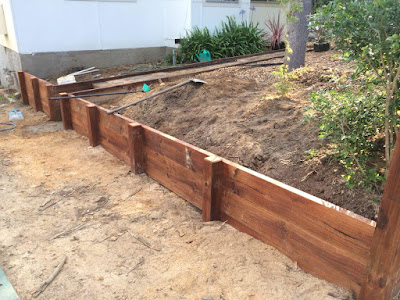My other sites; http://frankmenchise.com,http://diybrickwork.com,http://manneedsgod.co.uk
Anyhow, you can see our entire articles at this addresses, DIY brickwork
and, http://diybrickwork.com,
You can build retaining walls with timber. This retaining walls above is better if tradesmen build it, because it is complex, especially if you build the steps as shown above. But there are other simple retaining walls that you can do it yourself, as we will explain.
Timber sleeper retaining walls.
Welcome to our blog, D.I.Y Timber sleeper retaining walls, from our article, DIY Retaining walls
Building a low timber sleeper retaining wall is easy, just about everybody can do it, you can do it yourself, if you follow our explanation in this text here, all you need is a crowbar, a post hole shovel, a hammer a few long nails or screws, a saw, a type-measure and a few treated pine sleeper that today are easily available at most timber yards.
If you are in Brisbane Australia, these are a couple of addresses of local timber merchants and hardware to get what you want. If you are somewhere else, you need to find your own.
http://en.wikipedia.org/wiki/Bunnings_Warehouse
Now, let us assume that you have visited your local supply, and you have got all you need, so, you are ready to start, you have also worked out where you want your sleeper wall to go; So, start digging the first hole where the wall starts, you need to dig this hole about 600 mm or more in the natural ground for the post to be strong enough to hold the pressure of the retaining wall when the wall is back filled; you may have to concrete around the post for extra strength, but this is not a must do, if the retaining wall is low, because you can replace this with, packing the soil tightly around the posts and if you have some rocks, wedge them between the top of the hole you have dug and the post at ground level, because the rocks will exercise their pressure on a larger surface of the natural soil than the post, they will be able to hold back the soil pressure of the wall more easily, now that you have done the first post, you can repeat the same procedure for next post and so on.
The posts can be made from the same material of the sleepers; you can saw them to the right length and fix them in the ground as we have said above. Now, to make it easy let us say that your wall is going to be the length of a sleeper plank, and you have dug the two holes and fixed the two posts. So, now you can just place the first sleeper against the posts at the required level; the levels of the sleepers is better if you work it out from the top down, because it is easier to change the bottom than the top, you see, in this case you can always dig a bit or add a bit of soil at the bottom to fit the bottom sleeper. So, mark on the posts the level you want to reach with your last sleeper, and then mark down from this level the number of sleeper you are fixing on these posts, once you have done that you are ready to fix your sleepers on the posts.
This is the type of retaining wall we are talking about, in our text, except that our wall is shorter and we are using the same sleeper to make our posts.
Fixing your sleeper to the post
To fix the sleepers to the post now is simple, but still you need to do a few things right, if you want your wall to last a long time, with the materials you are using now; it is useful to know that in this case it is highly advisable that you use galvanized nails or screws to fix the planks to the posts, because the retaining wall is in contact with the wet or humid ground constantly, therefore, normal nails or screws will rust easily.
You have bought some 75 mm and 100 mm galvanized nails to do the job, so, you hope that you can drive these nails into the sleepers and posts just by using a hammer, because it is the fastest way to get the job done.
Okay, if you are good with your hammer and can drive nail easily it is the best way to go, provided that the timber is soft enough to do that, and if you have used treated pine sleeper it can be done, as all you need to do now is to place the sleepers where you have marked on the posts and nail them in, and then you can back-fill behind the retaining wall and the job is done.
But what about if you are using hardwood or old dry hardwood, because you got it very cheap from a second hand timber yard, because they were overstocked they sold this timber at a very special price, which was less than half the price of the treated pine sleepers; so, you were happy to buy it because it was cheap and the timber being hardwood lasts for a very long time, but now you may have a problem to fix the sleepers to the posts, because it is near impossible to drive nails into this old dry hardwood timber, unless you drill a hole for every single nail, and even then the nails can bend even if you are an expert with the hammer.
If this is the situation and it is hard to nail this timber together, you can overcome the problem by using couch screws or bolts, so, you use a drill and drill a hole for your galvanized couch screws or bolts and tighten the screws or the bolt nuts with a spanner. But if you don’t want to do this extra work and you want to use the galvanized nails that you have already bought, then you can do the following: drill a hole as deep as you can just use a bit a fraction smaller than the diameter of your nails, then try first with the 75 mm nails how you go, if it works and you believe that the nail go deep enough into the supporting post and hold well then your problem is solved, but if the nail bends or don’t go deep enough then you can try the following, and this is one of the last tricks of the old trade, which not many people know or use, this trick is not a trick at all and once you know it, you can feel even stupid for not thinking about it yourself; so what is it? Okay, when you pick up your nail to nail in the hole you have drilled, dip the point of the nail a couple of centimetre into a bit of Vaseline or mechanical grease, if this is not available just wet a bar of soap and rub the point of the nail on the wet soap, this greasing of the end of the nail will make it easier to drive it into any wood including dry old hardwood.
I believe that I have said enough about simple timber retaining walls, for you to have some idea how to build them. I also believe that this blog is already long enough. Therefore, in our next blog, we will talk about another type of retaining wall that can be easy to build, it is a type of concrete wall that the blocks are laid dry, so, anyone can have a go; and if you don't get it right the first time it is easy to fix. So see you soon in our next blog, Link Block Mortar-less walls. Part three. See you soon.
--------------------------------------
This blog-site is; old man-lifeworks
This blog is, D.I.Y Timber sleeper retaining walls, part two
IS TO BE CONTINUED WITH
D.I.Y Link blocks mortar-less walls, part three.
---------------------------
It is helpful if we keep our personal links handy. These links hereunder are my links, feel free to visit them.
https://sites.google.com/site/menfrancoreconciliation/
https://sites.google.com/site/prayersofreconciliation/
https://sites.google.com/site/godintheuniverse/
------------------------------------------















